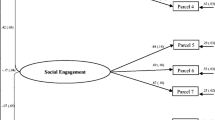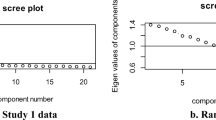Abstract
Tests currently available for measuring children's sensitivity to nonverbal aspects of communication have been criticized on methodological and conceptual grounds. The Child and Adolescent Social Perception Measure (CASP) was developed to meet the need for a clinically useful measure which examines social perception within a semi-naturalistic context. The CASP consists of 10 videotaped scenes, each of which lasts 19–40 seconds. The verbal content was removed through electronic filtering so that the ability to receive and interpret nonverbal social cues could be measured without bias from verbal cues. Children are shown the scenes and then questioned about the emotions portrayed. Based on standardization with 212 children and adolescents ages 6 to 15 years old, reliability (interrater, test-retest, internal consistency) and initial validity information are reported.
Similar content being viewed by others
References
Beck, L., & Feldman, R. S. (1989). Enhancing children's decoding of facial expression.Journal of Nonverbal Behavior, 13, 269–278.
Blanck, P. D., Buck, R. W., & Rosenthal, R. (1986).Nonverbal communication in the clinical context. University Park, PA: Pennsylvania State University Press.
Boyatzis, C. J., & Satyaprasad, C. (1994). Children's facial and gestural decoding and encoding: Relations between skills and popularity.Journal of Nonverbal Behavior, 18, 37–55.
Bullock, M., & Russell, J. A. (1984). Preschool children's interpretation of facial expressions of emotion.International Journal of Behavioral Development, 7, 193–214.
Costanzo, M., & Archer, D. (1989). Interpreting the expressive behavior of others: The Interpersonal Perception Task.Journal of Nonverbal Behavior, 13, 225–245.
Crick, N. R., & Dodge, K. A. (1994). A review and reformulation of social information-processing mechanisms in children's social adjustment.Psychological Bulletin, 115, 74–101.
Custrini, R. J., & Feldman, R. S. (1989). Children's social competence and nonverbal encoding and decoding of emotions.Journal of Clinical Child Psychology, 18, 336–342.
Doble, S., & Magill-Evans, J. (1992). A model of social interaction to guide occupational therapy practice.Canadian Journal of Occupational Therapy, 59, 141–150.
Edwards, R., Manstead, A., & MacDonald, C. J. (1984). The relationship between children's sociometric status and ability to recognize facial expressions of emotion.European Journal of Social Psychology, 14, 235–238.
Feldman, R. S., White, J. B., & Lobato, D. (1982). Social skills and nonverbal behavior. In R. S. Feldman (Ed.),Development of nonverbal behavior in children (pp. 259–277). New York: Springer-Verlag.
Gardner, M. (1990).Manual for the Expressive One-Word Picture Vocabulary Test-Revised. Novato, CA: Academic Therapy.
Gates, G. S. (1923). An experimental study of the growth of social perception,Journal of Educational Psychology, 14, 449–461.
Gnepp, J. (1983). Children's social sensitivity: Inferring emotions from conflicting cues.Developmental Psychology, 19, 805–814.
Hall, J. (1984).Nonverbal sex differences: Communication accuracy and expressive style. Baltimore: John Hopkins University Press.
Hall, J. (1978). Gender effects in decoding nonverbal cues.Psychological Bulletin, 85, 845–857.
Harrigan, J. (1984). The effects of task order on children's identification of facial expression.Motivation and Emotion, 8, 157–169.
Holder, H., & Kirkpatrick, S. (1991). Interpretation of emotion from facial expressions in children with and without learning disabilities.Journal of Learning Disabilities, 24, 170–177.
Koning, C., Manyk, K., Magill-Evans, J., & Cameron-Sadava, A. (1995).Application of the social interaction model and use of the CASP: A case study. Manuscript submitted for publication.
Lightfoot, C., & Bullock, M. (1990). Interpreting contradictory communications: Age and context effects.Developmental Psychology, 26, 830–836.
Martuza, V. R. (1977).Applying norm-referenced and criterion-referenced measurement in education. Boston: Allyn & Bacon.
McAlpine, C., Singh, N., & Kendall, K. (1991). Development and validation of videotaped role plays of six basic facial expressions of emotion.Bulletin of the Psychonomic Society, 29, 117–120.
Morency, N. L., & Krauss, R. M. (1982). Children's nonverbal encoding and decoding of affect. In R. S. Feldman (Ed.),Development of nonverbal behavior in children (pp. 181–199). New York: Springer-Verlag.
Morrison, R. I., & Bellack, A. S. (1981). The role of social perception in social skills.Behavior Therapy, 12, 69–79.
Nowicki, S., & Duke, M. P. (1994). Individual differences in the nonverbal communication of affect: The Diagnostic Analysis of Nonverbal Accuracy Scale.Journal of Nonverbal Behavior, 18, 9–35.
Philippot, P., & Feldman, R. S. (1990). Age and social competence in preschoolers' decoding of facial expression.British Journal of Social Psychology, 29, 43–54.
Reichenbach, L., & Masters, J. C. (1983). Children's use of expressive and contextual cues in judgments of emotion.Child Development, 54, 993–104.
Riggio, R. E. (1986). Assessment of basic social skills.Journal of Personality and Social Psychology, 51, 649–660.
Rosenthal, R., Hall, J., DiMatteo, M. R., Rogers, P. L., & Archer, D. (1979).Sensitivity to nonverbal communication: The PONS test. Baltimore: John Hopkins University Press.
Rourke, B. (1988). The syndrome of nonverbal learning disabilities: Developmental manifestations in neurological disease, disorder and dysfunction.Clinical Neuropsychologist, 2, 293–330.
Russell, R., Stokes, J., Jones, M. E., Czogalik, D., & Rohleder, L. (1993). The role of nonverbal sensitivity in childhood psychopathology.Journal of Nonverbal Behavior, 17, 69–83.
Semel, E., Wiig, E., & Secord, W. (1987).Clinical Evaluation of Language Fundamentals-Revised. San Antonio: Psychological Corporation.
Semrud-Clikeman, M., & Hynd, G. (1990). Right hemisphere dysfunction in nonverbal learning disabilities: Social academic and adaptive functioning in adults and children.Psychological Bulletin, 107, 196–209.
Shapiro, E. G., Hughes, S. J., August, G., & Bloomquist, M. L. (1993). Processing of emotional information in children with attention-deficit hyperactivity disorder.Developmental Neuropsychology, 9, 207–224.
Trimboli, A., & Walker, M. (1993). The CAST Test of nonverbal sensitivity.Journal of Language and Social Psychology, 12, 49–65.
Voeller, K. K. (1986). Right-hemisphere deficit syndrome in children.American Journal of Psychiatry, 143, 1004–1009.
Walker, M., & Trimboli, A. (1989). Communicating affect: The role of verbal and nonverbal content.Journal of Language and Social Psychology, 8, 229–248.
Wells, R. S., & Higgins, E. T. (1989). Inferring emotions from multiple cues: Revealing age-related differences in “how” without differences in “can,”Journal of Personality, 57, 747–771.
Wiggers, M., & Van Lieshout, C. (1985). Development of recognition of emotions: Children's reliance on situational and facial expressive cues.Developmental Psychology, 21, 338–349.
Wiig, E., & Harris, S. P. (1974). Perception and interpretation of nonverbally expressed emotions by adolescents with learning disabilities.Perceptual and Motor Skills, 38, 239–245.
Wing, L. (1981). Asperger's syndrome: A clinical account.Psychological Medicine, 11, 115–129.
Zabel, R. H. (1979). Recognition of emotions in facial expressions by emotionally disturbed and nondisturbed children.Psychology in the Schools, 16, 119–126.
Author information
Authors and Affiliations
Additional information
We acknowledge funding from the Glenrose Rehabilitation Hospital Research Grants Program. We thank each of the actors and actresses who generously volunteered their time to produce the videotape; the students and teachers in the schools who participated in the collection of the normative data; and the research assistants who worked many hard hours to make this all possible (Janet L. Smith, Kara Ryan, Dixie McLean, Kate Murie, Taslim Pardhan).
Rights and permissions
About this article
Cite this article
Magill-Evans, J., Koning, C., Cameron-Sadava, A. et al. The child and adolescent social perception measure. J Nonverbal Behav 19, 151–169 (1995). https://doi.org/10.1007/BF02175502
Issue Date:
DOI: https://doi.org/10.1007/BF02175502




